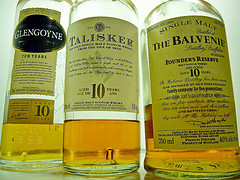
Credit: sashafatcat
The darker one.
It’s a natural bias. I know I have a bias when it comes to the color of my whisky.
The richer and darker the color, the more flavor I expect and, thus, perceive.
There’s a reason I used the analogy of Bud Light versus Guinness – I think my bias comes from my early days of drinking beer. You have your pale straw colored light beers, nearly devoid of flavor, and you have your dark porters and stouts, which pack a lot of malty goodness.
With whisky, I also associate the darker color with maturity. New make whisky is transparent and clear. It’s moonshine. Much of the color comes from the aging process inside a charred barrel. Presumably, the longer it’s aged and the darker the char of the barrel, the darker your whisky will be.
Would it surprise you to find out that companies have turned to artificial coloring to darken colors without having to age as long? They do it with caramel coloring, commercially known as E150a, and if you ask them, they do it for a variety of reasons.
Let’s knock out the basics of what it is and then go into the why.
What is this caramel coloring? It’s known as E150, which is a European designation, and it comes in four degrees of darkness (a through d, or class I to IV). It’s sometimes called spirit caramel.
How do they make Caramel E150? They caramelize commercially available food grade sweetners, like corn syrup and sucrose. In other words, they burn sugars. For Class I or A, there cannot be sulphites and ammonia compounds, which makes it the color additive of choice for whisky.
Can you taste the caramel sweetness? This is up for debate but the folks at Master of Malt did a blind taste test with 10 of their staff. Only one could pick out the glass of water with the caramel color additive (and they expected 1.66, since there were 10 participants and one of the six glasses had the caramel). While hardly a definitive study, at the very least it’s not going to obviously affect whisky.
Why do they use it? This is the billion dollar question right?
Companies will tell you that it’s for consistency. People expect a whisky to look a certain way and different batches will yield different colors, it’s just the nature of the maturing process. This is a legitimate argument and I buy it… however, I’m sure they also do it for branding.
Do you care if your whisky has caramel coloring? Do you avoid it? Ignore it? Had no idea? Don’t care?

I would prefer not to have the colouring, and I think the distilleries are starting to hear the buyers request for a more natural product. I won’t boycott a whisky for having it, but I will favor one that skips the colouring.
Is it just me or did you provide the answer to the “why do they do it?” question before you even asked it?
I provided one answer of why before I asked it. 🙂 There are a lot of different whys… I just provided the cynical one. 🙂
I don’t avoid a bottle with e150, but I prefer a bottle that shows the real spirit. I agree that when you look at the whisky and one is darker your instinct is that the darker is better and has more flavor. I think most of us know that is not necessarily true in whisky.
What are the known health effects associated with e150 and other caramel coloring additives?
As far as anyone knows, they’re safe.
I am allergic to food colorings, so I prefer natural whiskeys and am trying to source one that I like but it is hard – do you have any suggestions???
A word of warning. Many who read “Non Chilled Filtered” on a label assume that this also means no added colour or natural colour but it isn’t true. One does not imply the other.
A short list of Single malts (off the top of my head) that are readily available with no colouring:
Tomintoul 14 Years 46% (states on front label)
Glencadam 10, 15, 21 (whole range states No Added Colour stated on label)
Old Pulteney Noss Head and others in that range (states on tin)
Bruichladdich (most bottles state COLOURING FREE)
Glen Scotia range (States Natural Colour on label)
Kilchoman (As far as I know, the entire range)
Bunnahabhain 12 (States Natural Colour on the label)
Lastly, if you go to a specialist whisky shop then many if not most Independant bottlings are natural colour.
I appreciate the list, thanks Reb!
The Macallan and Highland Park do not have any added coloring
Correct about Macallan, but Highland Park does put caramel coloring in their 12, 18 and 25 year bottles, unfortunately.
Highland Park is now completely caramel (E150) Free.
The 12 was coloured in the 1990’s but no more.
I’ve been a scotch drinker for decades and am just now hearing about coloring in premium single malts. How is this allowed since what defines a whisky as single malt scotch is so specific? How can one determine which ones contains coloring a which do not, cetainly not from labeling. I find this a bit distressing.
Yeah that’s been a topic of discussion in whisky circles, I think it should be labelled.
In Germany the coloring has to be disclosed on the label. So you can put your favorite whisky in wine-searcher.com, choose Merchant Location: Germany, and follow a link to one of the larger retailers. It will say on the website “mit Farbstoff” if it has coloring in it. Here is an example.
Macallan uses Natural color from only “interaction of spirit and wood”. I’ve used it to replace my Caramel Colored Laphroaig.